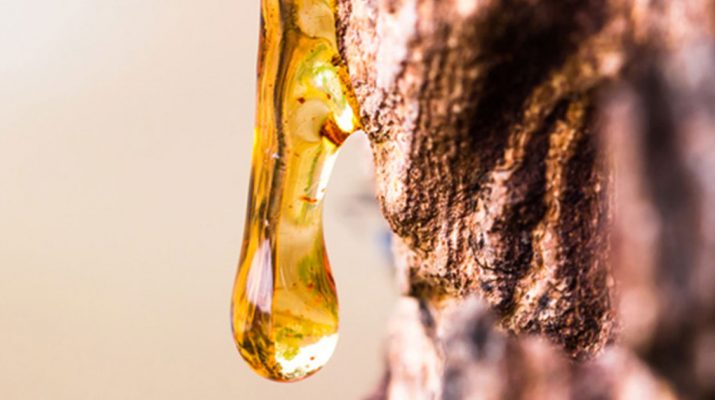Tree resin from coniferous trees has deep roots in traditional medicine for healing burns and wounds. Tree resins have made appearances in cultures all over the world, from Ayurvedic medicine and ancient Egyptian healing to Traditional Chinese Medicine and Aboriginal medicine of Australia.
You probably know more about tree resins than you might think. Does frankincense ring a bell? This odorous substance well known for making an appearance in a certain holiday story is collected from the Indian frankincense tree and is used today to produce Boswellia salves and essential oils.
Recently, a team of researchers published strong evidence for the use of tree resins in modern medicine.
What Are Tree Resins?
Not to be confused with sap, coniferous trees secrete resin (aka pitch) on their bark, both as a natural byproduct and as a means of fighting infection and pests. While sap is more transparent and watery, resin is tacky and thick. Deciduous trees do not produce resin, but coniferous trees produce both resin and sap.
Some of the most well-known tree resins are spruce, fir, cedar, balm of gilead, Canada balsam, Boswellia, dragon tree, and Canarium luzonicum. Most people are also aware of turpentine, which is a strong product derived from tree resin and is used as a paint thinner.
Traditional Treatments That Use Tree Resin
Resins have been used as an ingredient in traditional medicine for centuries, and are still used today. They can be processed into salves, essential oils, liquid extracts, and, in some cases even encapsulated and used as dietary supplements. Here are some examples:
Boswellia: A gum resin extract from the Indian frankincense tree, purported to have anti-cancer and anti-inflammatory properties. (4)
Bee Propolis: A byproduct of bees made from pine resin and mixed with wax flakes and pollen, believed to have antimicrobial properties. It can be taken internally or applied topically.
Guggul: A resin produced by the Mukul myrrh tree and used as traditional Ayurvedic medicine.
Do Tree Resins Have Health Benefits for Humans Too?
Janne J. Jokinen and Arno Sipponen published a research study in 2016 which made some very strong and promising claims about Norway spruce resin as a treatment for chronic wounds.
According to the duo, the spruce resin has “substantial anti-microbial, wound-healing, and skin regeneration enhancing properties”. They hoped to prove exactly how effective it could be for wounds associated with diabetes, malnutrition, vascular conditions, and systemic diseases- plus how it could fight drug-resistant bacterial infections.
Jokinen and Sipponen had actually been studying spruce resin in depth for a decade before publishing their findings. They’re strong advocates for its use because they’ve seen firsthand how spruce resin could be used medically to heal wounds, treat infections, reduce inflammation, and help heal pressure ulcers.
The team prepared a salve made from 10% pure Norway spruce resin and subjected it to a series of experiments, from in vitro tests of human pathogens like MRSA to clinical trials using patients with various chronic wounds and ulcers.
Of course, using tree resin medicinally isn’t new. The pair found their inspiration in traditional medicine from Norway and even older practices from ancient Egypt. A resin-based salve has been used to treat burns and wounds for centuries in some regions, and millennia in others.
How to Make a Pine Resin Salve
You can use this simple recipe to make your own pine resin salve for treating minor burns and wounds at home.
Ingredients
- ¼ cup pine resin
- ½ cup oil of your choice
- 1 ounce beeswax, grated
Directions
- Combine pine resin and oil in a double boiler over low heat.
- Once the resin has melted, strain the mixture and return to double boiler.
- Stir in beeswax over low heat until melted.
- Pour into sterilized glass jars and seal once cooled.
Apply a thin layer to the affected area. You can remove residue with rubbing alcohol. Alternatively, you can wipe residue away with oil, then rinse gently with soapy water.
Important: Cautions for Using Tree Resins
Tree resin is not suitable for everyone. There is a small risk of allergic reaction which could result in dermatitis (affecting about 1-3% of people). According to Jokinen and Sipponen, somewhere between 1 in 20 and 1 in 3 people who have a deodorant allergy will also be allergic to tree resins. An allergy test conducted by a dermatologist can help determine the risk of allergy. (7)
Just like essential oils, tree resins can contain extremely powerful chemicals. The fact that it’s naturally occurring does not make it necessarily safe, especially for internal use. The use of the pure gum spirit of turpentine as a home remedy has become increasingly popular over the last few years, but doctors are warning there can be serious side effects. (8)
Registered dietitian, Nicolette Pace warns, “The adverse effects and or fatalities are clearly going to outweigh any potential benefit. At the one teaspoon dosage, there are some serious reported adverse effects. It’s kidney-toxic… as little as three teaspoons are fatal.” (8)
While ingestion of gum spirit turpentine is surely much riskier (and ill-advised) than topical resin treatment, caution is still advised. If you’re interested in exploring the medicinal use of tree resins, speak to your medical care provider about ensuring whether it’s the right choice for you and how to use it safely.

